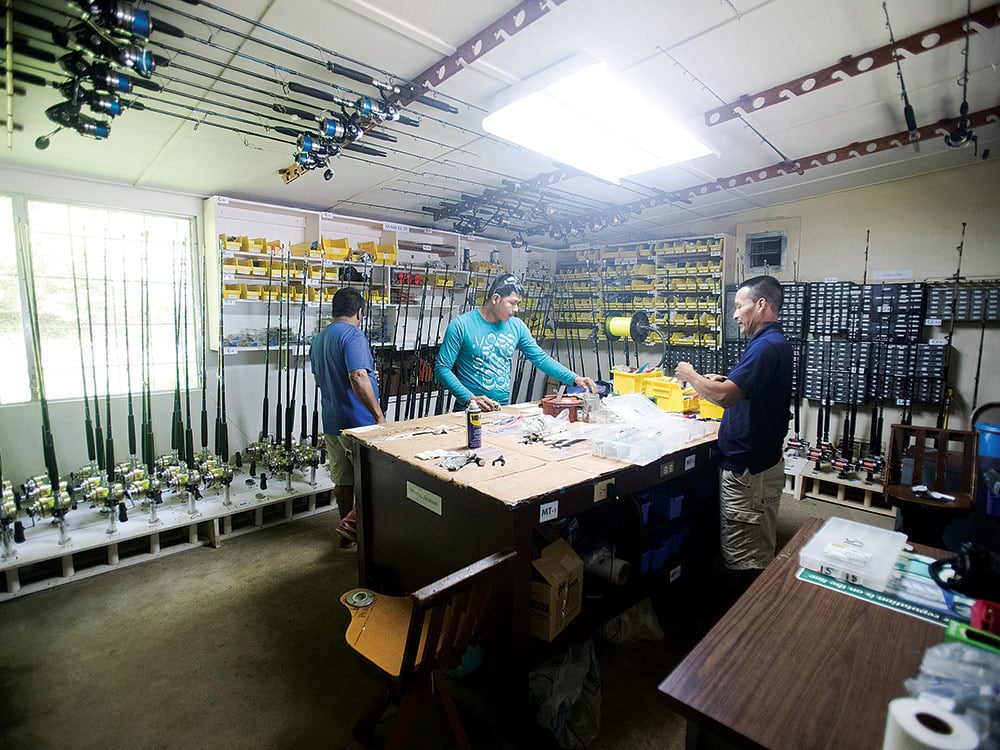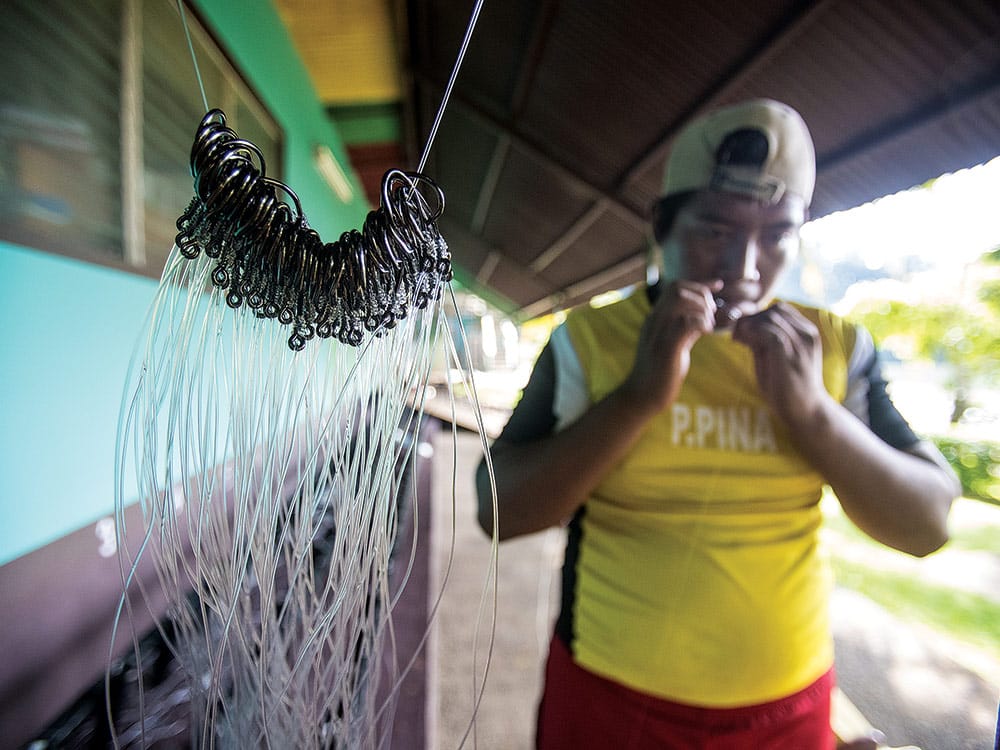
Flip through the International Game Fish Association’s book of world records, and you’ll see one destination that consistently stands out: Piñas Bay, Panama, home of the world-renowned Tropic Star Lodge. Just a few highlights: a 445-pound black marlin caught on 16-pound-test by Elizabeth Hogan, a 171-pound sailfish on 12-pound-test for Felipe Estrada, a 58-pound mahi landed by Gary Carter on 2-pound-test, a pair of big swordfish for the husband-and-wife team of Jerry and Deborah Dunaway, caught just seven days apart with Capt. Skip Smith in 1986. A 141.5-pound sailfish caught by Raleigh Werking on 4-pound-test line. The list continues. Even today, while some of the record-chasers may have turned their attention elsewhere, Tropic Star Lodge remains a top-shelf destination for the ultimate family-friendly fishing trip of a lifetime. Adventure Awaits, History Abounds Tropic Star is no ordinary fishing lodge: It’s perched like an osprey on the fringe of the Darien Rainforest, on the Pacific coast about 150 miles south of Panama City, Panama. The closest roads are more than 100 miles away — everything from fuel and food to spare parts arrives by either boat or airplane.

Guests venturing down will find themselves spending the night in Panama City, which, unlike most other Central American capitals, is upscale and metropolitan, with its high-rise skyscrapers, ritzy restaurants and urban-chic feel. The following morning, a single-engine puddle jumper ferries you down to the airstrip in Piñas Bay, and then a 10-minute boat ride deposits you comfortably at the lodge’s dock. Getting there is half the fun.
Another impressive feature of Tropic Star Lodge is the sheer amount of history behind it. While other top destinations and famed lodges might have their time in the spotlight before fading back into angling obscurity, Tropic Star has remained a bright spot, with consistently good fishing beckoning anglers decade after decade.
The legacy started in 1961 when Texas millionaire oil tycoon Ray Smith constructed the lodge, which opened two years later as Club de Pesca. Not long after, Smith landed an IGFA-record black marlin on 12-pound-test line; he was heard to remark that there would be all kinds of world records set there, and he was right. To date, the IGFA has approved more than 300 records from the area, more than any other destination in the sport-fishing world.

Unfortunately, Smith didn’t live to see his prophecy come true. In 1969, after his death, the property was sold to Edwin Kennedy, who renamed it Tropic Star Lodge to correspond with his other property, the Arctic Star Lodge in Canada. Floridian Conway Kittredge bought the property in 1976; one of his daughters, Terri Kittredge Andrews, and her husband, Mike, are the current operators. And it is their personal touch and feels-like-family hospitality that keeps Tropic Star Lodge a top attraction for anglers around the world, many of whom return each year.
Living on the Edge
Tropic Star Lodge has accommodations for 38 guests in 19 comfortable, air-conditioned rooms. And then there’s El Palacio: the palace. Back in the day, it was built for the lodge’s owners and has since been converted into an incredible mountaintop retreat, with stunning views of the bay and surrounding jungle. It has its own tram service, or you can walk the 122 steps up the side of the mountain (we usually take the tram). And with multiple bedrooms and a huge sunken living area, it’s the perfect spot for a family or large group.
The lodge’s fishing fleet consists of classic 31-foot Bertrams, each hull painted a different color, which are crewed by some of the best captains and mates in the business.
They are raised to fish, working their way up through the ranks and spending years on the water crafting the trade of finding and catching game fish. Richard White, a sharp young South African, is the lodge’s fishing director; he’s responsible for keeping all the boats and crews on point, and he’s an amazing asset to the operation.
The boats themselves are meticulously maintained, despite what can safely be called one of the world’s most challenging conditions for any charter operation. Just about every piece and part can be repaired or fabricated on-site, with railways in place to haul boats, rebuild engines, perform paint and fiberglass work, and much more. Mike Andrews personally designed the boats’ livewell systems, which incorporate tuna tubes for marlin baits with a large, above-deck well for smaller baits like goggle-eyes, which are perfect for tempting finicky sailfish, as well as casting to roosterfish or jacks in the surf. The tackle undergoes a similar keen eye.



Knowing that at any time a record-size game fish might appear, the line is replaced frequently, leaders are fresh, and knots are perfect. Each day of fishing, the boats are supplied with a simple tackle bag containing three sizes of pre-tied leaders with circle hooks already snelled and ready to go, plus lures, teasers and poppers. Rods and reels undergo near-constant maintenance and scrutiny to ensure a failure-free experience, although anyone seeking ultralight or fly records should probably bring their own gear.
Why It’s Special
Capt. Skip Smith has spent quite a bit of time at Tropic Star Lodge, chasing all kinds of records and generally catching the hell out of just about anything that swims. When I asked for his input on why it was such a special place, he simply says that Tropic Star is the complete package.
“You can target marlin — blacks and blues but also stripeys — plus sailfish and swordfish,” he says. Giant mahi, 50 pounds or more, are pretty common. Big yellowfin tuna and wahoo offshore. Cubera snapper, roosterfish and all kinds of jacks inshore. Amberjack and sharks on the reef. It’s pretty much wide-open. And the captains can catch them all. These guys can switch gears from live‑baiting black marlin to bottomfishing to casting poppers for roosterfish on the beach without missing a beat.

“And it’s easy to get to. Panama City is a three-hour flight from Miami, about three and a half hours from Houston, and it’s safe: You don’t need an armored Suburban to drive around the city,” he adds. “At the lodge, the food’s incredible, and you get this unbeatable service. They wake you up with coffee at your door every morning, you fish all day, head back to the lodge around 3 in the afternoon, and jump in the pool. You’re having cocktails with the other guests and swapping fish stories each evening. It’s just a really fun time.”
Many of the lodge’s world records fell as the times and tackle evolved. Famed fly fishermen like Mark Sosin and Stu Apte set records for sailfish on fly there in the 1960s and ’70s, with Apte’s 136-pound sailfish on 12-pound-test tippet from 1965 still on the books. By the 1980s, light-tackle fishing had become quite popular with traveling anglers, and another slew of records fell. Tropic Star moved to the top of everyone’s travel wish list.
An Angler’s Reef
Another reason for the lodge’s success lies just offshore: the famed Zane Grey Reef. A 20-minute run from the dock, the small seamount’s three rocky pinnacles rise up from the surrounding muddy bottom at around 350 feet deep to within 120 feet from the surface. Cold currents sweeping up from South America collide with the warm water coming from Costa Rica, creating strong upwellings and turning the entire place into a huge bait factory. It’s quite a sight to witness: As the sun rises, the bait is drawn to the surface as if by magic, and along with it, myriad game fish close behind in hot pursuit. Live‑baiting is the preferred technique for black marlin, so the crews deploy a few trolling feathers to fill the custom tuna tubes before slipping the circle-hooked baits back over the side.

If the bait is scarce or other species are on the hit list, then the crews will switch gears and go on the troll. The famed Panama strip bait is a popular choice — a bonito or mahi belly is stitched and sewn, then bridled to a circle hook. Panama strips are durable and will withstand repeated attacks by sails and big mahi much better than ballyhoo. Lures also produce plenty of bites, with the Mold Craft Super Chugger and Wide Range being consistent, popular standouts.
Smith related the expertise of the crews during the time he spent at Tropic Star at the helm of the 48-foot G&S, The Hooker. “Those captains would out-fish us just about every day,” he says with a chuckle. “Here we were, with a hot boat, radar and a depth sounder, and we were lucky if we caught half as many billfish as they did trolling belly strips and with minimal electronics. They’re just great fishermen.” A fanatic for properly tied knots, Smith doesn’t hesitate to cut and retie anything that isn’t up to his exacting standards. He says that when he climbs aboard the lodge boats for a day, he doesn’t have to touch a thing — every knot is perfect.

The Zane Grey Reef isn’t the only game at Tropic Star either. The blue marlin fishing can be exceptional in the blue water just offshore, and during certain times of the year, the Pacific seas come alive with yellowfin tuna ranging from footballs to tackle-testing giants. As the rainy season comes to an end, huge lines of debris from the rivers form offshore in the rips, and it’s here that marlin, tuna and enormous mahi can be found.
Time to Go
They say the best time to go fishing is when you have the time to go, and that definitely applies to Tropic Star. Just about year-round, there’s a hot bite going off around the lodge somewhere, with the exception of October and November when it’s closed for annual maintenance. January and February are among the best months for blacks on Zane Grey Reef, plus big sailfish and blue marlin, with February a top pick for a grand slam as the cooler water pushes in. April and May are transition months with plenty of tuna, and the sails arrive along with the bait in May into June.

Often, packs of feeding sailfish can be found as close as 2 miles from the dock, and multiple hookups are common. As the summer progresses, the fishing improves for the marlin, making an August grand slam a real possibility in near flat-calm seas. It does rain a bit in summer, but usually the showers are brief and tend to cool things off. The wahoo show up in force in early September. When the lodge reopens in late November, the rainy season tapers off, and the boats target blue and black marlin just offshore.
Conservation in Action
In a world of constantly changing rules and regulations, Tropic Star Lodge remains on the forefront of conservation efforts. It was one of the first operations to go entirely to nonoffset circle hooks when using live or dead bait. There is also a 20-mile exclusive zone around the lodge where no commercial fishing activity may occur, including longlining, as well as a billfish decree that protects all billfish species from commercial harvest. In 2010, Panama banned large-scale tuna purse seiners from Panamanian waters. Those moves continue to pay dividends today, and the fishing off Tropic Star remains almost as good as it was decades ago.
Whether you’ve got your eye on an IGFA world record or just want to take the fishing adventure of a lifetime with friends or family, be sure to check out Tropic Star Lodge. The memories are sure to last a lifetime.







